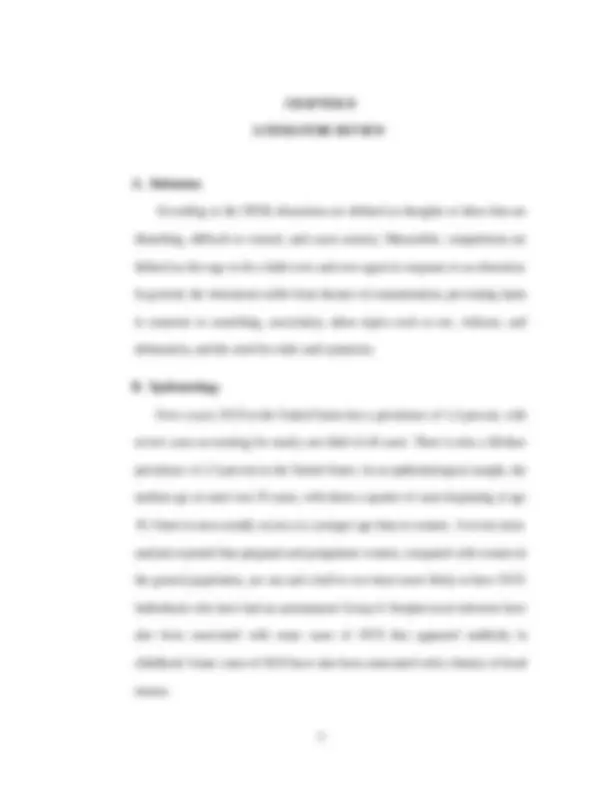








Study with the several resources on Docsity

Earn points by helping other students or get them with a premium plan


Prepare for your exams
Study with the several resources on Docsity

Earn points to download
Earn points by helping other students or get them with a premium plan
Community
Ask the community for help and clear up your study doubts
Discover the best universities in your country according to Docsity users
Free resources
Download our free guides on studying techniques, anxiety management strategies, and thesis advice from Docsity tutors
An overview of Obsessive-Compulsive Disorder (OCD), a common psychiatric disorder that causes unwanted thoughts or sensations (obsessions) with the urge to do something repeatedly (compulsions) in response to the obsession. the symptoms, prevalence, and comorbidities of OCD, as well as its differential diagnosis with other psychiatric disorders such as schizophrenia, autism spectrum disorder, and generalized anxiety disorder. The document also provides clinical practice guidelines and treatment options for OCD.
Typology: Essays (university)
1 / 12

This page cannot be seen from the preview
Don't miss anything!







Obsessive-compulsive disorder (OCD) is one of the most common psychiatric disorders and can often cause impairment in everyday life with a prevalence of around 1-3%. At least 92% of OCD sufferers have difficulty starting relationships because of a lack of confidence, 58% have difficulties in education, 47% have difficulties in working, and 40% are unable to work. Most OCD sufferers feel ashamed and hide their complaints for years before seeking treatment, so very few OCD sufferers receive appropriate pharmacological and psychotherapeutic therapy. About 75% of people with OCD also have comorbid psychiatric disorders, such as attention deficit hyperactivity disorder (ADHD), disruptive behavior disorder, major depression, other anxiety disorders, and alcohol addiction in adults. 3 According to the Diagnostic and Statistical Manual for Mental Disorders 3rd edition 4 (DSM IV), OCD is classified as anxiety disorder along with social phobia, specific phobia, panic disorder, post traumatic stress disorder (PTSD), and generalized anxiety disorder. Then, in the 5th edition of the DSM (DSM V), OCD is classified as obsessive compulsive related disorders (OCRD) which also includes excoriation disorders, body dysmorphic disorder, and trichotillomania.
C. Etiology
a. Recurrent and persistent thoughts, impulses, or images experienced at some time during the disturbance that are disturbing, inappropriate, and cause marked anxiety or distress. b. Thoughts, impulses, or images are not simply due to excessive worrying about real life problems. c. The person tries to ignore or suppress thoughts such as these impulses or images, or tries to neutralize them with other thoughts or actions. d. The person recognizes that the obsessive thoughts, impulses, or images are a product of their own thoughts (not imposed from outside as in thought insertion). Compulsions as defined by (a) and (b): a. Repetitive behaviors (eg washing hands, organizing, checking) or mental acts (eg praying, counting, repeating words silently) that the person feels compelled to perform in response to an obsession or according to rules that must be applied rigidly. b. Behaviors or mental acts aimed at preventing or reducing anxiety or preventing some feared event or situation; however, these behaviors or mental acts do not realistically relate to what they are doing to neutralize or prevent or are clearly excessive.
episodes and episodic occurrences of obsessive-compulsive symptomatology need to be emphasized.
The worrying in generalized anxiety disorder is similar to the obsession in OCD in that both refer to unwanted and time-consuming repetition of thoughts. When OCD symptoms lack compulsions, OCD will be mistaken for generalized anxiety disorder. The obsessions in OCD are more likely to have whimsical themes while fears of generalized anxiety disorder are more general and about realistic everyday life problems. F. Management Clinical recovery and full remission do not occur quickly. Thus, the goals of ongoing treatment are to reduce the frequency and severity of symptoms, improve the patient's function in daily life, and help the patient to improve his/her quality of life. Treatment goals also include increasing the patient's ability to cooperate with therapy, minimizing side effects of treatment, helping patients develop coping strategies for stressors, and educating patients and families about the disorder and its treatment. Selective serotonin reuptake inhibitors (SSRIs) are the most common type of medication prescribed for the treatment of OCD. SSRIs are often used to treat depression and also help treat symptoms of OCD. With SSRIs, it may take 8 to 12 weeks before symptoms start to improve, and treatment for OCD may require higher doses. Before the SSRI, the tricyclic antidepressant clomipramine was a treatment for OCD. However, it has more side effects.16,
Obsessive-compulsive disorder (OCD) is a psychiatric disorder that causes unwanted thoughts or sensations (obsessions) with the urge to do something repeatedly (compulsions) in response to the obsession. The obsessions and compulsions in OCD are characteristic and distinguishable from those of other psychiatric disorders. The most common OCD themes are contamination, preventing harm to someone or something, uncertainty, taboo topics such as sex, violence, and defamation, and the need for order and symmetry. OCD can occur in children to adults. Most OCD sufferers have nuclear families who have similar complaints. The onset of symptoms, the presence or absence of comorbidities, and adherence to medication can determine the outcome of OCD therapy. It is also important to educate the patient and family about the disorder and the stressors that can lead to a relapse.